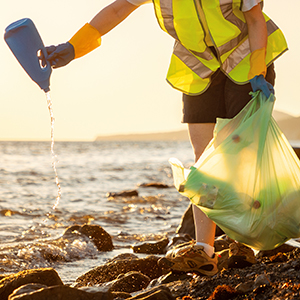
This month, I am excited to share excerpts of my recent conversation with Kjersti Aagaard, M.D., Ph.D., a renowned physician-scientist whose work on micro- and nanoplastics (MNPs) is helping to boost understanding of their pervasiveness and potential health effects. Emerging research shows that these plastics can infiltrate water, soil, and air — and our bodies.
MNPs have been associated with certain negative outcomes, such as need for interventions during labor and modestly lower scores on Apgar tests (which assess a baby’s overall health immediately after birth). However, whether there is a causal link between exposure to MNPs and poor health outcomes is unclear, and much work remains to learn how these substances may influence human biology. Dr. Aagaard, who is an NIEHS grantee and recipient of the 2023 Society of Toxicology Translational Research Award, emphasized the need for cautious interpretation of findings and further research to unravel the potential health effects of MNPs.
Our discussion also touched on practical steps aimed at reducing exposure to these tiny plastic particles, the importance of transparency in scientific communication, and why it is critical for health professionals to listen to the needs of patients. Dr. Aagaard also shared her personal path to a scientific career and what inspired her to be a researcher and an obstetrician-gynecologist specializing in maternal-fetal medicine.
MNPs are everywhere, but many questions unanswered
Rick Woychik: In March, during this year’s meeting of the Society of Toxicology, you gave a presentation titled “Dangers Unseen: Microplastic Pollution in the Placenta and Pregnancy Outcomes.” Can you share details of your work with our readers?
Kjersti Aagaard: Sure. A question I have posed is whether micro- and nanoplastics represent a “Silent Spring 2.0,” where similar to how Rachel Carson drew attention to the problem of pesticide exposure, perhaps we are on the brink of recognizing a significant, widespread environmental contaminant in the form of MNPs. Or have new technologies simply allowed us to better detect these substances in the environment, but maybe they are not actually causing major health problems? I don't think we know the answer yet. But I think we need to figure out whether MNPs are a real hazard to human health, or just a red herring.

My colleagues and I recently sampled a large number of placentas from normal-term pregnancies, and in every situation, we found MNPs. From one individual to the next, there were varying amounts of different plastics, ranging from a small amount of a nylon-based plastic to a large amount of a non–nylon-based plastic. We did not anticipate finding MNPs within all placentas, and I certainly did not appreciate that we would see such variability across individuals.
Within this normal-term pregnancy group, we also observed that differences in Apgar scores were associated with MNP levels. Scores were slightly lower than average but not dangerously low, and all the babies in this study had great outcomes. However, since there was a hint that there may be an association between MNPs and less-than-optimal term birth outcomes, more research with larger cohorts of mixed-term and preterm babies, with a variety of outcomes, would be a logical next step.
Assessing pregnancy outcomes, preterm birth
RW: What other outcomes did you observe, and what follow-up research do you have planned?
KA: Our team looked at the intrapartum period, meaning during labor and delivery. We noticed an association between higher levels of MNPs and need for medical augmentation during labor, meaning that the mothers required a boost to move their labor along.
There are a number of reasons a mother in labor might need augmentation, so this study was hypothesis-generating for us. In future studies, we will aim to determine whether there is a significant association between MNPs and medical disorders of pregnancy, like preeclampsia and diabetes. We are also in the process of exploring a potential relationship between the presence of MNPs and preterm birth.
Potential cardiovascular risk
RW: What else would you like people to know about MNPs?
KA: A recent NIEHS-funded study published in the New England Journal of Medicine was a watershed moment in the field, in my view. The clinician-scientists leading this important study collected tissue of patients having coronary artery bypass procedures and discovered that individuals with MNPs in their artery plaque had significantly higher risk of heart attacks, strokes, or death compared with patients without these micro- and nanoplastics. That is a very compelling association.
As a general rule, congregated particles — whether they are foreign microplastics or cellular plaques on blood vessels — can lead to blocked vessels. A subsequent slowdown of blood flow or crack in the plaque can lead to risk of heart muscle damage and ischemic heart disease.
Also, at the Society of Toxicology meeting, there was impressive data presented on MNPs in testicular tissue. There should be a barrier between the blood and the testicles, so this was an example where these tiny plastics are actually crossing over into places that were not anticipated. There should be a pretty good cellular barrier between your blood and testicular tissue.
Examining the role of diet
RW: Earlier, you mentioned individual variation in the amount and distribution of MNPs. What do you think accounts for such variation?
KA: When we think about MNPs, it’s important to remember that we ingest them and they get absorbed into the gut, go into the bloodstream, and do different things. Generally, in most of the human body, lipid to lipid, or fat droplet to fat droplet, connections tend to enable crucial cellular and particle movement and communication in our bodies. So, for example, if we start to think about how MNPs can move from the blood to the heart muscle or testicle tissue, it will be important to explore whether fat in the diet may be enabling or exacerbating this process.
It is quite possible that lipids, which are the business-end molecules of dietary fat, may be part of why we see this different distribution of MNPs in the body, and I think that's going to be a very important consideration as we move forward. Addressing that question would help us understand why some people may have bad health outcomes and in other people, these MNPs are potentially just kind of silent, non-participating things.
The New England Journal of Medicine article I mentioned suggests that these MNPs deposit within plaques and collect there. However, they must be excreted at some level, right? They would not be detected in sewage waste if they were not passing through our systems. Current data does not suggest that MNPs are part of a Velcro scenario, where the substances come in through our food and water and cling to us permanently. But understanding which tissues they deposit in and why, and how they cross barriers like the testicular barrier — which is supposed to block such particles — is crucial. Is it just due to the flow of lipid particles, or is there another mechanism? Is there a relationship with the immune system or our gut microbiome that may lead to more leaky mucosal or epithelial cell barriers?
As much as we in research and medicine hate to admit it, we really don't know the answers to any of these questions in this new field of MNP science. So, it is incumbent on us not to create panic and instead be fully transparent about what we do not yet know. In recent years, our patients and community neighbors have increasingly told us: Tell us what's going on but also tell us what you don't know, what uncertainties you face. I cannot emphasize enough how uncertain I am about MNPs and whether or not they pose a real and inherent danger to human health. I am certain they can collect in the placenta and the plaques of arteries, and I am impressed by others’ data suggesting they cross the testicular barrier to collect there. But I cannot say with any degree of certainty that MNPs themselves are causing poor health outcome. We simply don’t know: do MNPs represent Silent Spring 2.0, or nothing to worry about?
Reducing exposure to MNPs
RW: What would you say to people who might be concerned about MNPs?
KA: Although evidence on the health effects of MNPs is not yet definitive, there are practical steps that folks can take to reduce exposures. For example, consistent with the recommendations of multiple professional organizations, we encourage women, when possible, to directly breastfeed. We recognize that most women will need to pump milk, and encourage non-plastic alternatives for freezing, storing, and reheating if able.
Also, these days, many of our grocery items come packaged in plastic, so when we get home, we can consider ways to store our food in glass or steel containers. It is generally recommended to avoid heating food in plastic, and to consider durable cardboard, paper, or glass alternatives. These are just some ways to potentially reduce exposure to MNPs while waiting for the science to catch up.
One of the arenas I am most excited about is the potential for widespread community collaboration as research focused on MNPs and human health continues. There are real and necessary opportunities for physicians, midwives, environmental health experts, industry professionals, economists, policymakers, and educators to come together as we prioritize research, and communicate our findings. If we err on the side of caution and address practical ways to reduce our potential exposure to MNPs, we will need new and cost-effective methods for processing and storing food that fit our lives of today and tomorrow. Clearly, we can’t all revert to growing and canning our own food like our grandparents and great-grandparents, but neither ought we continue our current trajectory of increasing dependency on plastic packaging.
So, perhaps we can work with manufacturing and the food industry to identify safer plastics and glass alternatives. No sector of our community wants to cause harm — whether businesses, government, physicians, scientists, or product manufacturers. Maybe it’s time for us to come together and address these important questions collaboratively, and with a keen eye focused on the health of all people and our planet.
(Rick Woychik, Ph.D., directs NIEHS and the National Toxicology Program.)









